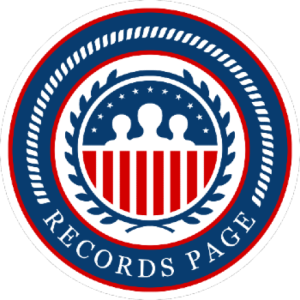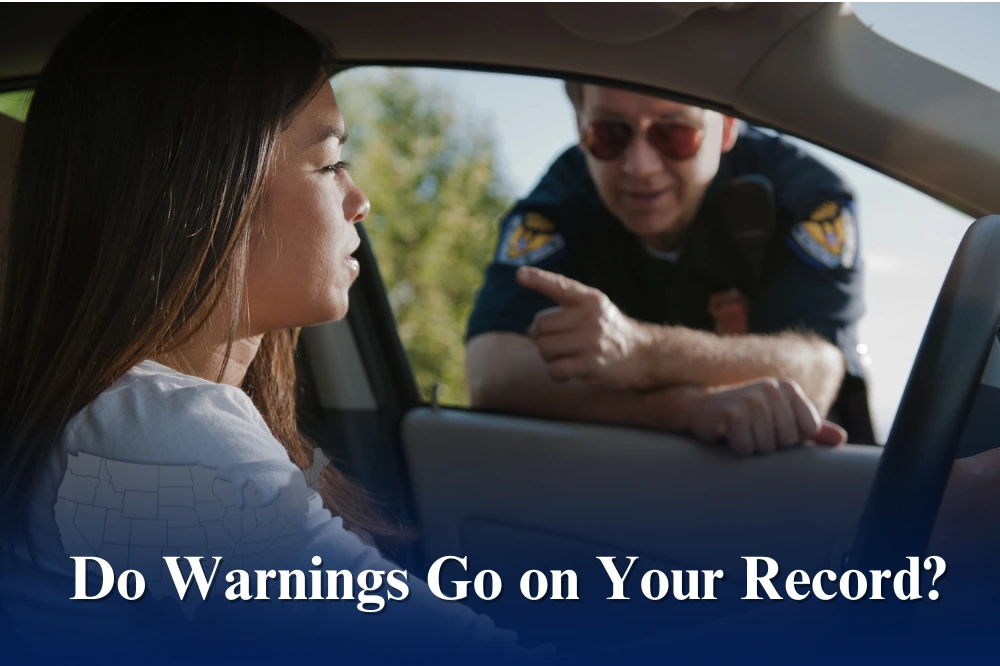
A common concern after being pulled over for a traffic infraction is whether warnings go on your record. A traffic warning is usually given by an officer to let you know you’ve violated a rule, but without attaching any fines or penalties.
Warnings don’t typically lead to criminal charges, but they can still be noted by law enforcement and may cause trouble for you down the road; this will be covered in depth below. In most cases, they won’t show up on your driving record, though it can depend on where you are and how serious the violation was.
This streamlined resource outlines how warnings are documented and what they might mean for your record.
How Long Do Warnings Last?
The jurisdiction in which a warning was given has a significant impact on how long it remains on your record.
Certain areas may collect documentation of warnings but only retain them for a short period of time – long enough to identify patterns or monitor drivers’ recurrent problems. Alternatively, other jurisdictions may keep these records for a very long time, sometimes even indefinitely.
Generally, unless the warning leads to a citation or ticket associated with a serious violation or results in additional legal action, its effect on your record is minimal – but exceptions do exist; what’s considered as minor warning in one location could be treated much differently elsewhere. A warning’s long-term impact is decided by how it is recorded and the period that it remains on record.
Different Types of Warnings Explained
Warnings generally fall into two categories: verbal and written.
Verbal warnings – being informal, are often issued on the spot and rarely involve any kind of formal documentation. These are usually given for minor infractions. Reminders rather than punishments are the purpose of these warnings, which are free of consequences or record entries.
Written warnings – however, are more official in nature even if they are still not as serious. These typically include paperwork and, in many cases, are filed into official records.
While both types can be noted by law enforcement, it’s the written warnings that are more likely to be officially recorded in their system, where they might remain longer than expected—depending on local practices or policies. Yet, they generally don’t affect your driving record.
The crucial difference is that, with a written warning, any other officer who may pull you over for a future driving infraction can see the prior warning attached to your vehicle or name, making it more likely that you won’t get off so easily this time.
The Purpose & Consequences of a Warning vs a Ticket
Officers often use a traffic warning, whether verbal or written, as an informal way to advise a driver of a violation without imposing fines or other penalties. It’s a chance to correct behavior before it gets out of hand or becomes common practice.
On the other hand, tickets or citations act as formal notices of traffic violations and come with immediate consequences: such as fines, or in some cases, mandatory court appearance or even legal action. Furthermore, such offenses often affect your driving record – potentially increasing insurance rates over time.
Unlike warnings, tickets are recorded and are added to your permanent driving record, sometimes impacting your future driving privileges if they add up or become excessive.
How To Best Proceed: Steps To Take After Receiving a Warning From the Police
Police warnings may seem overwhelming, but understanding your next steps on how to approach receiving one helps you stay prepared and have peace of mind if this happens to you.
Stay calm and be polite. Whether or not you agree with the warning itself, it’s vital to remain composed to show respect. Nothing will be solved by escalating the encounter.
Understand and acknowledge the violation. Ask nicely for clarification if an officer’s explanation is brief and unclear to prevent making the same mistake twice.
Preventing repeat violations. By changing your driving behaviors, and taking the warning seriously—verbal or written—you can help reduce the number of subsequent traffic stops and police encounters.
Ensure you have proper documentation. Always keep your driver’s license or ID card, insurance, and vehicle registration on you for a smoother interaction and to avoid adding further infractions or increasing the potential for a citation.
Keep a record. In case of future disputes or confusion, save a written warning as proof; request the badge number and name of the officer as well if it is not included on the documentation you’re given regarding the stop.
Monitor your driving history. The majority of warnings don’t appear on official records, but there are exceptions. Reviewing your driving history on a regular basis might help you prevent surprises.
Learn local driving laws. Rules about warnings vary by state; some document them officially, while others keep it informal. Check your state’s policies for clarity.
Seek legal help, if needed. If the warning seems unfair or somehow affects your record, consider seeing a traffic lawyer for advice on your options.
Maintain driving responsibly. A warning is an opportunity to improve; use it to adapt your behavior and avoid future issues like penalties, fines, or accidents.
Document the details of the incident. If you believe the warning was unjustified, note important information such as the time, location, weather, and the officer’s statements for future use.
How To Check Your Driving Record
Verifying the details of your driving history or record can vary from state to state, so be sure to seek information specific to the state(s) you typically drive in.
For example, in Illinois, the Office of the Secretary of State allows anyone to access their driving records.1, 2 You must enter the information exactly as it appears on your driver’s license in order to continue. This contains information like:
- Driver’s license number
- Date of birth
- The last four digits of your Social Security number
- The issue date and the expiration date printed on the license
- License class information
- Height (noted in feet and inches)
- Weight
- DD number
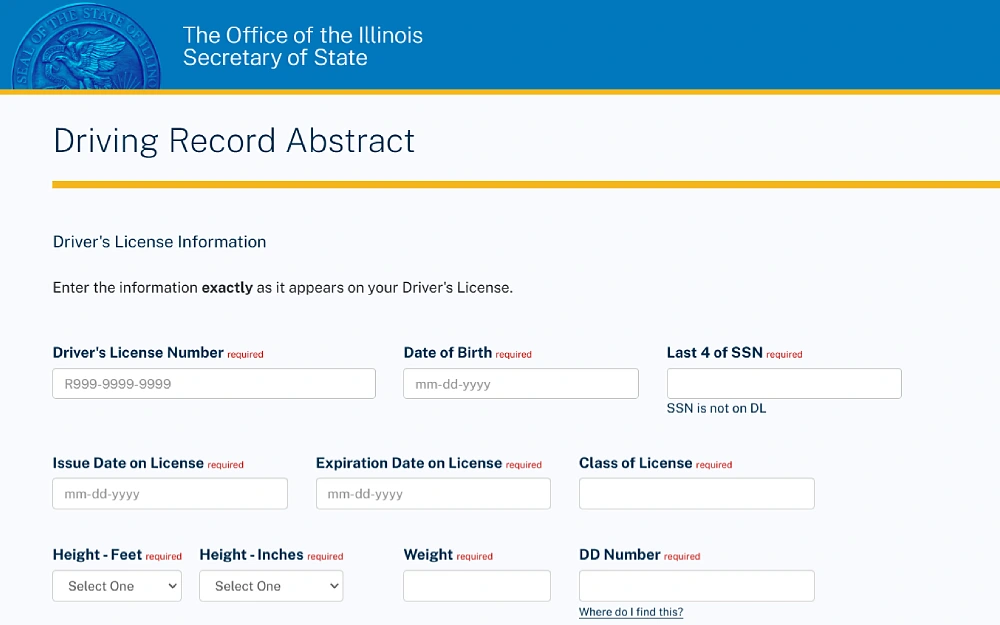
For a seamless procedure, double-check everything to make sure it matches what’s on the license. For further information or details about additional record types, complete a free Illinois public document search for insights into anything from marriages, births, and court cases to arrests or criminal records.
Alternatively, in Michigan, accessing vehicle history information requires compliance with the Driver Privacy Protection Act (DPPA) and a valid purpose.3, 4 You can purchase a copy of your driving record online, by mail, or in person at an office, each with specific requirements and processes.
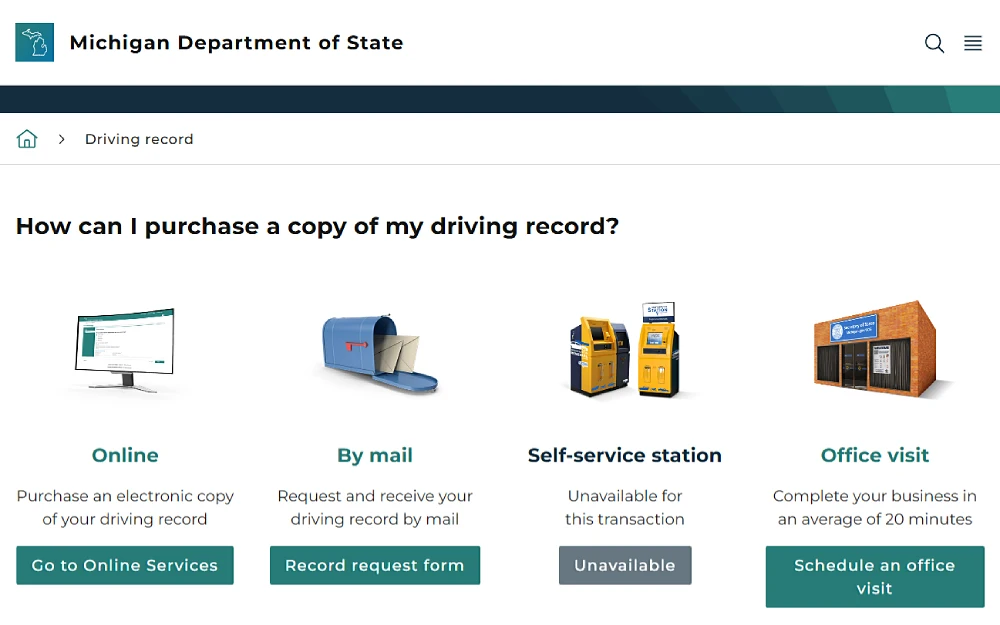
Online, you’ll need to create an account via MiLogin, authenticate your details and pay the fee using a credit/debit card or e-check. Your record will be accessible for only seven (7) days so saving it to your device is recommended.
For mail requests, a completed record request form and payment must be sent.5
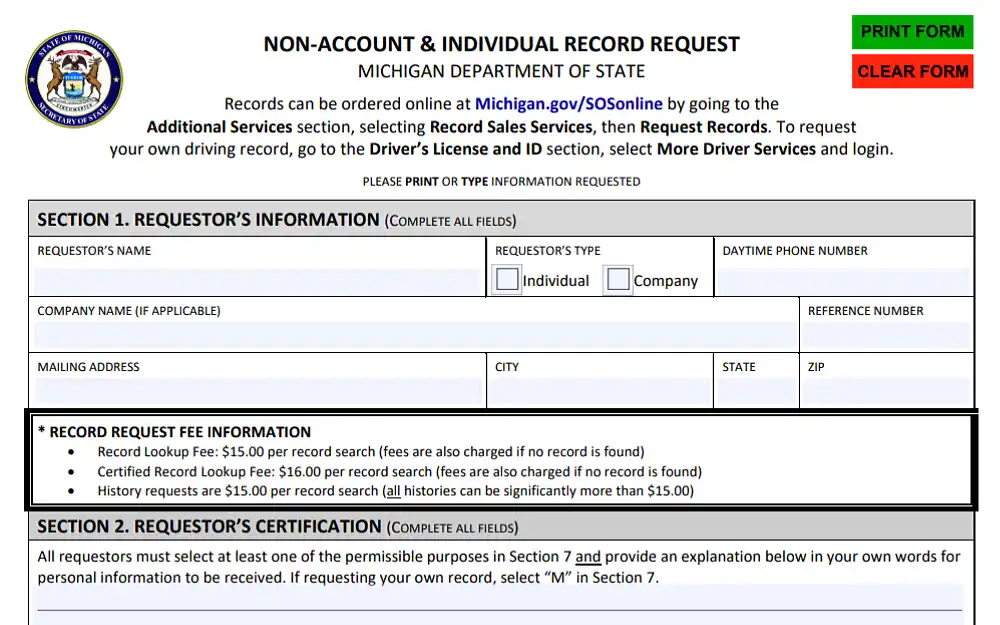
Office visits, which can be scheduled and typically take around 20 minutes allow you to request a certified copy directly with an associated cost.6
To fix errors on a driving record, you can use online services or visit a Secretary of State Office for an update.
Michigan Department of State
Driver Record Activity Unit
7064 Crowner Drive
Lansing, Michigan 48918
Fax: 517-636-7525
For unreceived actions, it’s best to call the Information Center at 1-888-SOS-MICH for help.
Certified records may be needed for legal or job purposes; confirm requirements in advance. Michigan residents typically purchase their own records though commercial and government entities have special access.
For interested parties who’d like to check background checks and other files such as court records, warrants, etc. can follow the procedure for finding public files in Michigan.
Look up “[state] driving record information” on any search engine for insights into other states.
Impact of Prior & Multiple Warnings
Written or spoken warnings are meant to deter risky behavior, encourage compliance, and increase general safety awareness. However, over time, their impact may fade, especially if overused or dismissed as unimportant.
Moreover, documented warnings serve as a basis for escalating penalties and supporting legal actions, showing that drivers were given chances to amend their behavior. Automated systems – such as speed cameras – issue warnings as a preventive measure and use the data collected to identify high-risk or danger zones for policy development.
Still, overuse or inconsistent enforcement of warnings can lead to driver indifference, diminishing their overall value. In such cases, stricter enforcement or alternate interventions may become necessary to maintain their intended purpose.
Can You Dispute or Remove Warnings From Your Record?
Verbal traffic warnings don’t appear on your driving record. Since they’re not considered official penalties or citations, there’s no reason to worry about expunging them.
However, if a written warning is documented and you believe it’s impacting your record unjustly, you can contact your local DMV or licensing authority to clarify its status and inquire about any available options for removal.
All said, to answer the question of if warnings on your record or not, the answer depends on where you are and the type of violation you’ve allegedly committed. However, in most cases, warnings are not permanently recorded on your driving record, though they may still be documented by law enforcement for tracking purposes.
References
1Illinois Secretary of State Office. (n.d.). Contact. Retrieved January 06, 2025, from <https://www.ilsos.gov/contact_us/>
2Illinois Secretary of State Office. (2024). Driving Record Abstract. Retrieved January 06, 2025, from <https://apps.ilsos.gov/drivingrecord/>
3Michigan Department of State. (n.d.). Driving record. Retrieved January 06, 2025, from <https://www.michigan.gov/sos/all-services/driving-record>
4University of Michigan School Scholarship Repository. (n.d.). Staking Out the Border Between Comandeering and Conditional Preemption: Is the Driver’s Privacy Protection Act Constitutional Under the Tenth Amendment? Retrieved January 06, 2025, from <https://repository.law.umich.edu/mlr/vol98/iss2/6/>
5Michigan Department of State. (2023, September 29). BDVR-154 Record Request for Non-Account & Individual. Retrieved January 06, 2025, from <https://www.michigan.gov/sos/-/media/Project/Websites/sos/27lawensn/2-bdvr154.pdf?rev=3d8fc45175cf4d7bab6ae0f7de74896a>
6Michigan Department of State. (n.d.). e-Services. Retrieved January 06, 2025, from <https://dsvsesvc.sos.state.mi.us/TAP/_/>
